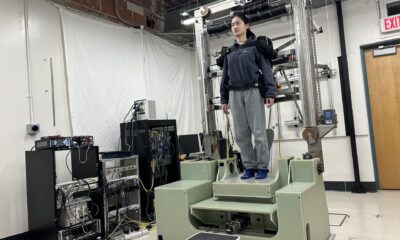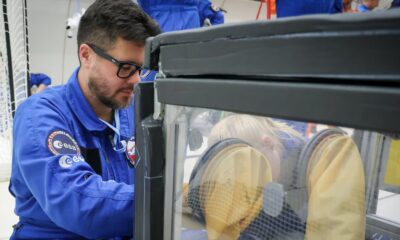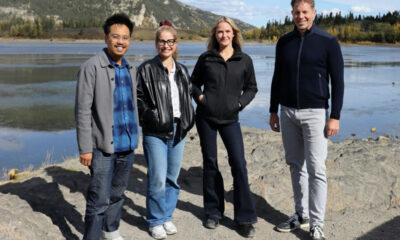Science
UBC’s Innovative Robot Reveals Brain’s Balance Mechanisms

Researchers at the University of British Columbia (UBC) have developed a groundbreaking robot that provides new insights into how the brain maintains balance. This innovative “body-swap” robot could lead to advancements in fall prevention, benefiting millions of older adults and individuals with balance disorders.
The findings, published in October 2023 in the journal Science Robotics, were made possible through collaboration with scientists at Erasmus MC. The research team discovered that the brain compensates for delays in sensory feedback by interpreting spatial and temporal information in similar ways to how it adjusts to changes in body dynamics. These revelations could inform the design of assistive devices and rehabilitation strategies aimed at improving balance.
How the Robot Works
Standing upright involves intricate coordination within the brain, which processes signals from the eyes, inner ears, and feet to maintain stability against gravity. Delays in these signals can lead to balance issues, particularly in older adults or those with conditions like diabetic neuropathy and multiple sclerosis. Dr. Jean-Sébastien Blouin, senior author of the study and a professor in UBC’s School of Kinesiology, likened the experience to steering a car with a delayed response.
The UBC robot utilizes advanced physics to manipulate how participants perceive their body dynamics. By standing on force plates connected to a backboard driven by high-precision motors, individuals experience altered forces that simulate various conditions affecting balance. The system can increase inertia, making the body feel heavier, or adjust viscosity, altering how quickly the body can respond to shifts in balance.
In one key feature, the robot introduces a brief delay of approximately 200 milliseconds, simulating the lag in nerve signal transmission. This delay tricks the brain into adjusting its balance responses, mirroring the real challenges faced by individuals with slower sensory feedback.
Key Experiments and Findings
The research team conducted three distinct experiments to explore these dynamics. The first test involved introducing a delay, revealing that participants swayed significantly, often exceeding the limits set by the virtual system. This demonstrated how the brain struggles to compensate for delayed feedback.
In the second experiment, the researchers examined whether altering body dynamics could replicate the effects of the delay. By lowering inertia or applying negative viscosity, participants experienced similar instability, indicating that the brain interprets changes in balance in overlapping ways.
The final experiment tested whether enhancing body dynamics could counteract the impact of delayed feedback. By increasing inertia and viscosity, participants were able to regain control, with their sway reduced by as much as 80 percent, and most did not fall. According to lead author Paul Belzner, these results were surprising and provided evidence that modifying body dynamics can help mitigate stability issues caused by late feedback.
The implications of this research are significant, particularly for fall prevention among older adults. Falls are a leading health risk in this demographic, often resulting in loss of independence and imposing substantial costs on healthcare systems. In Canada alone, falls cost the healthcare system over $5 billion annually.
Looking ahead, potential applications for this research include wearable devices that provide gentle resistance during swaying movements or robotic trainers designed to teach patients how to adapt to slower feedback. The insights gained from the UBC robot may also aid engineers in creating more stable humanoid robots.
The robotic platform will soon be relocated to UBC’s new Gateway health building, where it will continue to support research at the UBC Balance and Falls Research Centre, the School of Kinesiology, the School of Biomedical Engineering, and the Centre for Aging SMART. This collaboration aims to further develop technologies that enhance fall prevention and promote healthier aging.
The project received funding from the Natural Sciences and Engineering Research Council of Canada and the UBC School of Kinesiology Equipment and Research Accelerator Fund, underscoring the significance of this research in advancing our understanding of balance and stability.
-

 Politics3 weeks ago
Politics3 weeks agoSecwepemc First Nation Seeks Aboriginal Title Over Kamloops Area
-

 World4 months ago
World4 months agoScientists Unearth Ancient Antarctic Ice to Unlock Climate Secrets
-

 Entertainment5 months ago
Entertainment5 months agoTrump and McCormick to Announce $70 Billion Energy Investments
-

 Lifestyle4 months ago
Lifestyle4 months agoTransLink Launches Food Truck Program to Boost Revenue in Vancouver
-

 Science5 months ago
Science5 months agoFour Astronauts Return to Earth After International Space Station Mission
-

 Technology3 months ago
Technology3 months agoApple Notes Enhances Functionality with Markdown Support in macOS 26
-

 Top Stories2 months ago
Top Stories2 months agoUrgent Update: Fatal Crash on Highway 99 Claims Life of Pitt Meadows Man
-

 Lifestyle3 months ago
Lifestyle3 months agoManitoba’s Burger Champion Shines Again Amid Dining Innovations
-

 Politics4 months ago
Politics4 months agoUkrainian Tennis Star Elina Svitolina Faces Death Threats Online
-

 Sports5 months ago
Sports5 months agoSearch Underway for Missing Hunter Amid Hokkaido Bear Emergency
-

 Politics4 months ago
Politics4 months agoCarney Engages First Nations Leaders at Development Law Summit
-

 Technology5 months ago
Technology5 months agoFrosthaven Launches Early Access on July 31, 2025





















